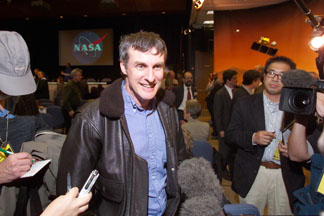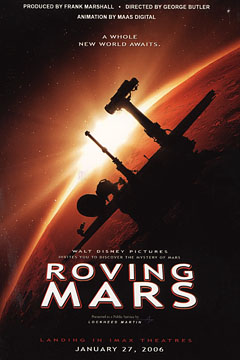Cornell goes to the movies: Mars and Steve Squyres' rovers star in IMAX spectacular
By Lauren Gold

Thanks to a combination of coincidence, luck and a few handy connections, the red planet is a star in the story of the durable twin Mars rovers, which hits the extra-big screens in IMAX theaters in New York, Washington, D.C., and two dozen other cities across North America on Friday, Jan. 27.
The 40-minute film, "Roving Mars," is the story of the journey of the rovers Spirit and Opportunity -- as well as the journey of their creators. Directed by George Butler and produced by Frank Marshall, the movie chronicles the rovers' early development to their treks across two very different regions of Mars. The rovers are still going strong, having far exceeded their projected life span of 90 days.
Equipping the rovers with IMAX-quality cameras was a priority for NASA's Mars Exploration Rover (MER) mission from the beginning. "We set for ourselves the goal of making two robot field geologists," says Steve Squyres, Cornell's Goldwin Smith professor of astronomy and the mission's principal investigator. Cornell astronomy Associate Professor Jim Bell, leader of the panoramic camera (Pancam) team for the mission, says that meant giving the rover cameras 20/20 stereo vision -- "the first time we've had human resolution on Mars."

Documenting the mission for a film, though, was not originally in NASA's plans. That idea came together in part thanks to Squyres' younger brother, Tim, an Academy Award-nominated film editor (and like his older brother, a Cornell alumnus). Tim pitched the idea to Butler and Marshall, who then did their own share of pitching to NASA before they were granted access for filming.
The pivotal point occurred just before Spirit's launch in June 2003, when tension was at its peak and the team didn't want to be slowed down by a camera crew. So Butler rented the IMAX theater at Cape Canaveral to show the MER team his last movie: a documentary about the journey of Antarctic explorer Sir Ernest Shackleton.
"You could feel this chill go through the room," says Steve Squyres. From that moment, Butler's film crews had full access.
But neither Butler's crews nor the rovers' cameras on Mars could capture images of the rovers themselves once they were in orbit. That's where Cornell alumnus Dan Maas, creator of Emmy-nominated Maas Digital in Ithaca came in. Maas had created animation for the MER mission in the past -- as well as for other NASA missions, including Deep Impact.
Maas delivered brilliantly, says Steve Squyres -- creating a seamless transition between actual footage and 12 minutes of lifelike animation that stays true to the mission data. It's all meticulously "real," the mission's lead scientist says, from the placement of rocks on the surface of Mars to the way the rovers bounced down on opposite sides of the planet in January 2004 enclosed in pillows of hand-stitched airbags.
"Those are the actual bounces. That's not a Hollywood recreation," he says of Maas' computer-created feeling of authenticity. "Dan did spectacular work."
The film, which is sponsored by Lockheed Martin and released by Walt Disney Co., is not heavy on science but is an exhilarating ride that captures the spirit of exploration to a faraway place -- in thrilling full color.
"That doesn't happen when you put a picture on your monitor; it doesn't happen when you make a printout," says Bell. "It will be that immersion experience -- of being completely surrounded and overwhelmed with Mars. I want people to have the experience of being there. I think it's going to be spectacular."
And if viewers -- especially the youngest ones -- get inspired to do some exploration of their own, says Steve Squyres, the movie will have served its purpose. Because when Mars hosts its first human explorers, they most likely will be, Squyres believes, today's elementary school students.
"What I would most like is if some kid watches this movie and says, 'I want to go there,'" says Steve Squyres. "And then actually does it."
Media Contact
Get Cornell news delivered right to your inbox.
Subscribe